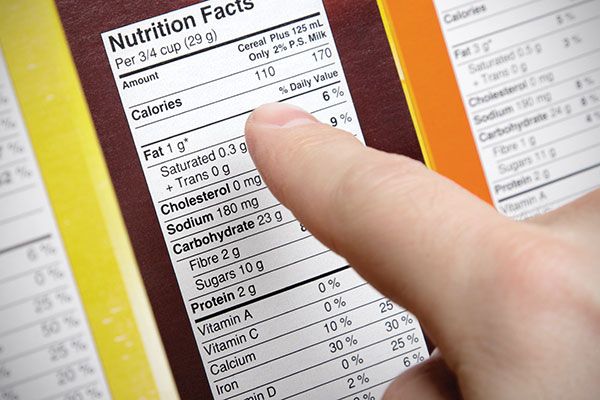Decoding food packaging

Packaged food in Canada is legally required to prominently display nutritional information, so that Canadians can make informed decisions when we buy and consume pre-made foods. Food processing in the modern age is not just about preserving or combining ingredients, it is also a tool to create convenient products, designed to minimize food waste and maximize profits.
Since there are a variety of goals involved in food processing, the end result is a myriad of options, catering to a wide variety of needs. For example, individuals with gluten sensitivity can seek out products that use alternative flours to replace wheat flour, eliminating gluten without drastically changing the feel or flavour. This mandatory labeling makes it easy for people with dietary restrictions to choose the right product by simply reading the ingredients and nutrition facts panel.
In addition to the mandatory labeling, many products are also marketed with attention-grabbing lines related to nutrition like: 'low in sugar!', 'low in fat!', or 'high in fibre!' This sounds good in theory, but don't be fooled; there isn't enough information in that phrase to make an informed decision. Low in fat means no more than what it says, there isn't a lot of fat in this product, but how do we define 'a lot'? Some products go a step further and specify how much less fat, but there are no guidelines for how much fat should be in any given product, and every brand has their own recipe and method, so it is impossible to police an open-ended claim like 'high in fibre'. The problem is that these phrases are convincing, so when you choose the 'low fat' version you believe it’s good for you.

This becomes even more problematic when it affects other parts of our daily lives, for example 'I chose low-fat crackers and low fat cheese for my snack, so I can have an extra-large portion’. The reality is this information is useless without context, if a 20g serving of crackers normally contains 2.5g of fat, and they introduce a 20% reduced fat version of the same cracker, that serving only lost 0.5g of fat. Knowing that a serving contains one half gram less fat than the regular serving contains is a much less convincing argument than 20% reduced fat, which many people interpret as 'I can eat 20% more'.
When weighing our options in the grocery store, there are two pieces of information required by law to be displayed on the outside of the packaging.
The first, and arguably most important is the ingredient list. For someone with a life-threatening food allergy or dietary restriction (due to medication or otherwise), knowing exactly what ingredients make up the product you're going to consume is a very serious matter. Peanuts have a notoriously dangerous allergic reaction, an anaphylaxis response causes the tongue and throat to swell, restricting or even completely closing the airway. There are many foods that cause anaphylactic reactions.
In addition to dietary restrictions, we also have dietary preferences. For example, some people try to avoid using products containing certain ingredients because of the way they are sourced, or for religious or ethical reasons. Thankfully, this information is available to us immediately upon picking up a product from the shelf, in the ingredients list, and this empowers us to make better decisions for our health and for our planet.
The second food labelling requirement is the 'Nutrition Facts' panel. If the ingredient list outlines what is in the product, then the nutrition facts help us understand how much of the product is made up of various macro-nutrients and minerals. Carbohydrates (with specific values for sugar and fibre), fat (with specific values for saturated and trans fats), and protein are our three primary nutrients; we use all three to make energy for activity, and fat and protein are important for building and repairing tissue in the body. The quantity of each nutrient is listed beside its name, in grams or milligrams, alongside a % value which indicates what portion of your recommended daily intake each serving will provide you. These '% of daily value' figures are calculated based on a healthy adult consuming 2000 total daily calories , so if you have an active lifestyle or consume more than 2000 calories daily you will want to adjust the figures according to your individual needs.
Sodium and cholesterol are also listed, along with vitamin A, vitamin C, calcium, and iron. These are very important minerals/vitamins to the body, that's why it is mandatory to display them on all food packaging. Vitamin A is used by the body to build tissue, it supports the immune system, and it is crucial to our vision. Vitamin C is an antioxidant, but we also use it to repair damaged body tissue and vitamin C is crucial to the formation of stable collagen. Calcium is the important mineral that our bones are made of, but calcium does so much more for us! Our muscles wouldn't move at all, our blood would not clot properly to stop bleeding, and we couldn't generate the electrical impulses that are sent racing across our nerves, without adequate calcium. Iron is well known as the critical component in hemoglobin, the part of our red blood cells which holds oxygen for transport through the body.
Each of these vitamins and minerals were selected to be displayed because we are completely dependent upon them, we can't make enough internally and so we must get our supply from our diet.
One of the things we tend to pay all of our attention to is the number of calories per serving. Calories are our primary unit to measure food energy, that is, the amount of energy we can extract from a food serving through metabolism. Different nutrients are broken down into different amounts of energy, for example: A gram of carbohydrate or protein typically contains four calories of energy, while a gram of fat contains about nine calories of energy. It's not a bad idea to keep track of your caloric intake and energy expenditure to keep them balanced, but cutting out calories to maintain that balance also has the effect of limiting your sources of nutrients. The ideal diet can best be described as balancing the nutritional needs and the energy needs of the body.
During this festive season of celebration, feel confident in your fully-informed food and drink decisions. Happy Holidays, and feast wisely!
We can help you move and feel better.
Book an appointment today.